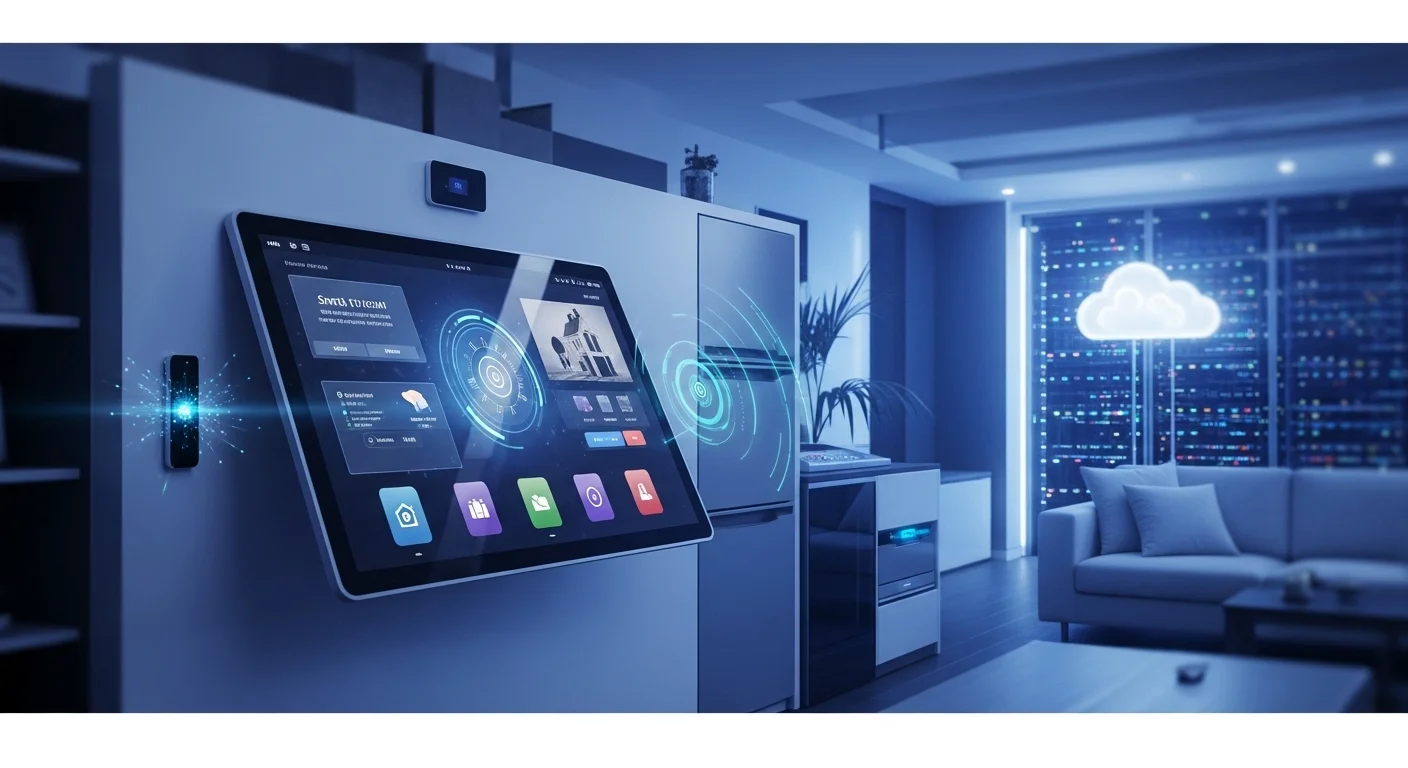The Smart Home Revolution: Your Business Playbook for 2025

Executive Summary
For years, I've watched the term 'smart home' evolve from a niche hobby for tech lovers into a full-blown technological revolution. Today, a smart home is more than just a cool gadget; it's a network of connected devices that simplifies life, enhances security, and saves money. For businesses in real estate, hospitality, or even healthcare, this isn't just a trend—it's a massive opportunity. As we gear up for 2025, advancements in AI and new standards like Matter are set to make these systems smarter and more integrated than ever. This guide is my deep dive into the essentials: the core components, the installation know-how, and the business strategies that will help you capitalize on the future of modern living.
Table of Contents
Table of Contents
- What is a Smart Home System and Why Does it Matter?
- The Core Components of a Smart Home System
- The Real-World Benefits for People and Businesses
- A Deep Dive into Protocols and Platforms
- Smart Business Models for the Connected Home
- Best Practices for Installation and Management
- Cybersecurity: Your Non-Negotiable Smart Home Strategy
- Advanced Tips to Future-Proof Your System
What is a Smart Home System and Why Does it Matter?
Let's cut through the jargon. A 'Smart System Home' or 'smart home' is simply a home where key devices are connected to the internet and can talk to each other. I'm talking about your lights, thermostat, security cameras, door locks, and even your coffee maker, all working together in a single, intelligent network. This network, a key part of what we call the Internet of Things (IoT), lets you control everything remotely from an app or with your voice. But the real magic isn't just turning things on and off from your couch. A truly smart home learns your habits, automates routines, and makes your life easier, safer, and more efficient without you even having to ask.
From a business standpoint, this technology is a gold rush. I've worked with real estate developers who see property values increase simply by including a solid smart home automation system as a standard feature. In hospitality, luxury hotels are using it to create unforgettable guest experiences—imagine a guest controlling their entire room environment with a voice command. The benefits for healthcare, especially in assisted living, are life-changing. These systems can monitor the well-being of residents, detect falls, and provide an easy way to call for help, offering both independence and peace of mind. As we look toward 2025, the AI driving these systems is becoming so advanced that homes won't just be reactive; they'll be predictive. That's not just a technological leap; it's a massive business opportunity.
The Core Components of a Smart Home System
To understand a smart home, you need to know its building blocks. Think of it like a team where each player has a specific role. At the center of it all is the smart home hub or controller. This is the brain of the operation—the coach that calls the plays. Devices like an Amazon Echo, Google Nest Hub, or Apple HomePod act as this central command post, listening to your instructions and telling all the other devices what to do. They use different wireless 'languages' to communicate, like Wi-Fi, Bluetooth, Zigbee, and Z-Wave. The big news on this front is a new universal translator called Matter, which is designed to let devices from different brands finally work together without any headaches. It's the most exciting development for 2025 and beyond.
The rest of the team consists of the smart devices themselves, which are the players on the field:
- Smart Lighting: This is often everyone's first step into the smart home world. A smart home lighting system with connected bulbs and switches can change the entire mood of a room, improve security by making it look like someone's home, and cut down on energy waste.
- Climate Control: Smart thermostats are the star players here. They learn your schedule to save energy without you feeling a thing. I've seen them slash utility bills by a noticeable margin.
- Security and Access: This is your defense. Smart cameras, video doorbells, and smart locks let you see who's at your door from anywhere and provide incredible peace of mind.
- Appliances and Entertainment: From smart refrigerators that tell you when you're out of milk to a 'Movie Night' scene that dims the lights and starts the film with one command, this is where convenience really shines.
- Sensors: These are the unsung heroes. Motion sensors trigger lights, water leak sensors prevent floods, and smoke detectors can alert both you and the fire department. They are the eyes and ears of your smart home automation system.
Finally, you have the user interface—usually a simple app on your phone that brings control of your entire home into one place. A professional smart home system installation ensures all these parts work together flawlessly, creating an experience that feels like magic.
The Real-World Benefits for People and Businesses
The reason smart home technology has exploded is because its benefits are real and tangible. For homeowners, it starts with pure convenience. Automating daily chores, like turning on lights or starting the coffee pot, just makes life simpler. Then there's the energy efficiency. A smart home system doesn't just save you a few cents; it can make a serious dent in your monthly utility bills by eliminating wasted energy. For me, the biggest personal benefit has always been the enhanced security. Knowing I can get an instant alert if something's wrong at home, whether it's a potential break-in or a water leak, is invaluable.
For businesses, these user benefits translate directly into commercial advantages. Real estate developers can market smart-enabled properties as premium, secure, and green. I've seen insurance companies start to offer discounts for homes with certified smart home system installations because things like water and smoke detectors reduce their risk. Utility companies can partner with homeowners to better manage the energy grid. The entire ecosystem is also a job creator, fueling growth for installers, cybersecurity experts, and data analysts. As we move into 2025, the focus is shifting from simple automation to proactive assistance—a home that doesn't just report problems but helps prevent them. This continuous evolution is what makes the smart home space one of the most exciting fields in technology today.

A Practical Guide to Smart Home Tech and Business Strategy
Let's go deeper. To truly leverage a Smart System Home, whether for personal use or as a business solution, you need to understand the technology under the hood and the strategies that turn cool gadgets into profitable ventures. A successful smart home system is a blend of the right hardware, seamless communication, and a thoughtful setup. As we head toward 2025, getting these foundational choices right is more important than ever, especially with new standards promising to make everything simpler.
A Deep Dive into Protocols and Platforms
The communication technology is the nervous system of your smart home. Think of these protocols as different languages devices use to talk to each other:
- Wi-Fi: This is the language everyone knows. It's great for devices that need a lot of data, like security cameras. The downside? If too many devices are talking at once, it can get 'noisy' and slow down your network.
- Bluetooth: Perfect for short, quiet conversations, like when you first set up a device or for a smart lock connecting to your phone as you approach the door.
- Zigbee & Z-Wave: These are secret, super-efficient languages designed just for smart devices. They create a 'mesh' network where devices can pass messages along, making the network incredibly reliable and long-range. They're my go-to for things like a full smart home lighting system or a web of sensors. They do require a hub to translate for your Wi-Fi network.
- Matter: This isn't a new language, but a universal translator. I've been waiting for something like this for years. Backed by giants like Apple, Google, and Amazon, Matter allows devices that speak different languages to understand each other perfectly. This is the key to a future where you can buy any Matter-certified device and know it will just work. It will revolutionize smart home system installation.
Equally important is the platform, or ecosystem, you choose to manage everything. This is your main control panel:
- Amazon Alexa: The most popular kid in school, with the widest range of compatible devices. Fantastic for creating easy voice-controlled routines.
- Google Home/Assistant: Incredibly smart and intuitive, leveraging Google's powerful AI to understand what you want, sometimes before you do.
- Apple HomeKit: The fortress. If your top priorities are privacy and security, HomeKit's strict standards and seamless integration with Apple devices are unmatched.
- Samsung SmartThings: The power user's choice. It's incredibly versatile and lets you create some of the most complex and customized automations imaginable.
- Home Assistant: For the true tech enthusiast. It's an open-source platform you run yourself, offering ultimate control, privacy, and customization. It's a steeper learning curve, but the payoff is total freedom.
Smart Business Models for the Connected Home
I've seen many businesses thrive in the smart home market, and the most successful ones sell solutions, not just products. Here are some of the most effective business techniques I've encountered:
1. Professional Consultation and Installation: This is the foundational service. Most people are excited by the idea of a smart home but intimidated by the setup. Offering expert design, installation, and training is a high-value service that creates a perfect, hassle-free experience for the client.
2. Smart Home as a Service (SHaaS): This is a game-changer for B2B. Imagine managing all the smart technology for an entire apartment complex or a chain of vacation rentals. You handle the monitoring, updates, and support for a recurring monthly fee. The property owner gets a premium feature to offer, and you get a stable revenue stream.
3. Specialized Cybersecurity Services: Every smart device is a potential door for hackers. Businesses specializing in securing smart homes—by setting up firewalls, isolating devices on the network, and monitoring for threats—are providing an absolutely essential service that clients are willing to pay for.
4. Data-Driven Proactive Services: With user permission, the data from smart devices is invaluable. An appliance manufacturer could offer a predictive maintenance service, alerting a customer that their washing machine is about to break down and scheduling a repair. This builds incredible brand loyalty.
5. Insurance and Real Estate Partnerships: This is a win-win. Partner with insurance companies to offer lower premiums to clients who install certified smoke, water, and security sensors. Work with real estate agents to offer 'smart staging'—installing a system in a home for sale to showcase the connected lifestyle and boost its appeal.
The future of this industry lies in these integrated service models. As standards like Matter make the hardware part easier, the real value will come from the services that make a smart home secure, efficient, and truly intelligent.

From Theory to Practice: Tips for a Flawless Smart Home Experience
Alright, let's get our hands dirty. Having a box of smart devices is one thing; creating a truly intelligent home that works for you is another. Whether you're a business owner implementing these solutions or a tech lover building your dream setup, these are my field-tested strategies for getting it right.
Best Practices for Installation and Management
A great smart home is built on a great foundation. Rushing the installation is the number one mistake I see people make. Plan it out.
1. Your Network is Everything: Before you buy a single gadget, test your Wi-Fi. Walk around your house with your phone. Got dead spots? That's where your new smart camera will fail. A mesh Wi-Fi system is almost always a worthwhile investment for consistent coverage. My pro tip: If you're building or renovating, run Ethernet cables. It's cheap to do and will pay off massively by keeping high-bandwidth devices off your Wi-Fi.
2. Pick an Ecosystem and Start There: While Matter will help things play nicely together, you'll still have a primary 'home base' like Google Home, Amazon Alexa, or Apple HomeKit. Pick the one that feels most natural to you. Starting with one system makes everything less confusing.
3. Start Small, Think Big: You don't have to automate your whole house in one weekend. I always advise clients to start with something that offers an immediate, satisfying win. A smart home lighting system is perfect for this. So is a smart thermostat, where you can see the energy savings. This lets you learn the ropes and expand your smart home automation system thoughtfully.
4. Buy Quality, Not Just a Low Price: In the IoT world, you get what you pay for. Stick with reputable brands that provide regular software updates. Those updates are what patch security holes and keep your devices working properly. That cheap, no-name smart plug might seem like a bargain until it stops getting support and becomes a security risk on your network.
5. Keep a Logbook: This might sound tedious, but trust me. When you have 50 devices, you won't remember which is which. A simple spreadsheet tracking device names, locations, and what they do will be a lifesaver for future troubleshooting.
Cybersecurity: Your Non-Negotiable Smart Home Strategy
I cannot stress this enough: a connected home must be a secure home. This isn't a feature; it's a requirement.
- Lock Down Your Router: This is your front door. Change the default admin password immediately. Use a strong, unique password for your Wi-Fi and enable WPA3 encryption if you can.
- Use the Guest Network: Your router has a guest network for a reason. Let your visitors use that. Keep your main network for your trusted devices only.
- Isolate Your Gadgets: This is a more advanced tip, but it's powerful. Create a separate network (a VLAN) just for your IoT devices. If a hacker compromises your smart toaster, they'll be trapped there and won't be able to access your personal computer or files.
- Password Manager is Your Best Friend: Every single smart home app and account needs its own strong, unique password. A password manager makes this easy.
- Enable Two-Factor Authentication (2FA): Turn this on for your main smart home accounts (Google, Amazon, Apple). It's the single best thing you can do to prevent unauthorized access. Even if someone steals your password, they can't get in without your phone.
- Update, Update, Update: Turn on automatic updates for your devices and router. Those updates contain critical patches that protect you from the latest threats.
Advanced Tips to Future-Proof Your System
Once you're set up and secure, you can start creating the real magic. The goal is a home that anticipates your needs.
Get Creative with Scenes: Don't just set timers. Create experiences. A 'Good Morning' scene can slowly fade up the lights, raise the thermostat, and start your favorite playlist. My 'Goodbye' scene turns off every light, locks the door, and arms the security system with one word as I walk out.
Let Sensors Be Your Triggers: The smartest homes run on sensor data. A motion sensor can turn on dim hallway lights for a safe trip to the kitchen at night. A door sensor can trigger an alert if a medicine cabinet is opened when it shouldn't be. A water sensor under the sink can not only alert you to a leak but also trigger a smart valve to shut off the main water line, preventing a disaster.
Bet on Matter: As you buy new gear, look for the Matter logo. This is your ticket to a future-proofed system. It ensures your investment today will still be relevant and compatible with the broader smart home systems of 2025 and beyond, making any future smart home system installation a breeze.
By following these strategies, you can create a smart home that's not just a novelty but a secure, efficient, and genuinely helpful part of your life or business. For more reading on how technology is shaping business, the Harvard Business Review's Technology section is an excellent resource.
Expert Reviews & Testimonials
Sarah Johnson, Business Owner ⭐⭐⭐
Solid information on Smart Home Systems. As a business owner, I would have loved to see a few more real-world examples to sink my teeth into.
Mike Chen, IT Consultant ⭐⭐⭐⭐
A helpful guide to smart homes. It definitely cleared some things up for me, though a few of the technical bits could have been a little simpler.
Emma Davis, Tech Expert ⭐⭐⭐⭐⭐
Fantastic article! This was incredibly thorough and genuinely helped with my specialization. Everything was explained perfectly.



